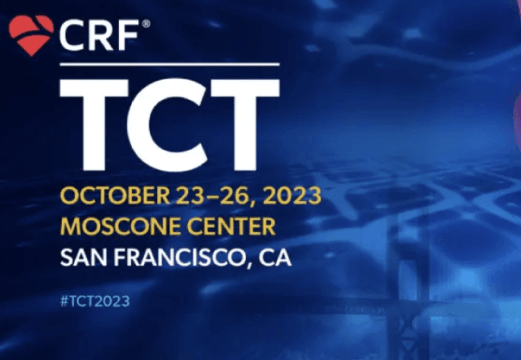The negative impact of mitral regurgitation (MR) on patient mortality, morbidity, and quality of life is widely recognized. However, only 15% of patients are referred for surgery due to their high surgical risk and low ejection fraction. Transcatheter edge-to-edge repair has become an important alternative for this group of patients. For subjects with degenerative MR,…
TCT 2023 | VIVA Trial: TAVR vs. SAVR in Patients with Severe Aortic Stenosis and Small Aortic Annulus
Degenerative aortic stenosis (AS) is the most common valve condition. A significant number of AS patients presents a small aortic annulus (SAA), especially women. Treating this group of patients remains challenging, seeing as they have a high incidence of suboptimal hemodynamic results. Despite the development of TAVR (transcatheter aortic valve replacement), the current guidelines do…
TCT 2023 | TRILUMINATE Trial: Health Status after TriClip
Severe tricuspid regurgitation (TR) has been associated with higher mortality, increased risk of hospitalization for cardiac failure (CF), reduced functionality and poor health status. Tricuspid edge-to-edge repair (T-TEER) with TriClip effectively reduces TR with low risk of post-procedural complications. The TRILUMINATE Pivotal trial (Trial to Evaluate Cardiovascular Outcomes in Patients Treated with the Tricuspid Valve…
TCT 2023 | PARTNER 3 Low Risk: 5-Year Follwup
TCT has presented the 5-year clinical and echocardiographic outcomes of low-risk patients with severe aortic stenosis treated with transcatheter aortic valve replacement (TAVR) using balloon-expandable Sapien valves vs. surgical aortic valve replacement (SAVR). The first primary end point was a non-hierarchical composite of all-cause mortality stroke or rehospitalization. The second was a hierarchical composite including…
TCT 2023 | EXPAND G4
The EXPAND G4 is a prospective multicenter single arm study on real life patients. It included a total 1,164 patients with primary (PMR) and secondary (SMR) mitral valve regurgitation treated with MitraClip G4. Research was carried out at multiple locations across US, Europe, the Middle East and Japan. Key outcomes assessed aspects such as all-cause…
TCT 2023 | ALIGN AR Trial
Dr. Thourani has presented the ALIGN AR, a single arm, multicenter and non-blinded trial on the use of JenaValve in symptomatic patients with severe aortic regurgitation and high surgical risk. Safety primary end point was a composite variables including all-cause mortality at 30 days, stroke, major bleeding, vascular complications, kidney failure, need for definite pacemaker…
TCT 2023 | EVOLUT Low Risk: 4-Year Follow-up
In recent years, there has been a steady increase in the use of transcatheter aortic valve replacement (TAVR) in younger patients, with an average age of 74 years, as observed in US medical records. This trend goes alongside encouraging durability results, as demonstrated in the 10-year NOTION study, where structural valve degeneration (SVD) with first-generation…
TCT 2023 | SWISS-APERO: One-Year Events After Left Atrial Appendage Closure with Amulet or Watchman FLX Device
It has been observed that the persistence of an opening in the left atrial appendage after percutaneous closure (LAAC) is associated with a higher risk of embolic events. Among the most commonly used devices for left atrial appendage closure are the Watchman FLX and Amulet devices. This study, known as SwissApero, represents the first randomized…
TCT 2023 | The WATCH-TAVR Study
In the TVT registry, around 40% of the patients eligible for transcatheter aortic valve replacement (TAVR) had atrial fibrillation, and there were high levels of adverse events after starting anticoagulant treatment, especially with oral anticoagulants (VKAs), primarily due to bleeding. The purpose of this study was to assess the feasibility, safety, and efficacy of combined…

